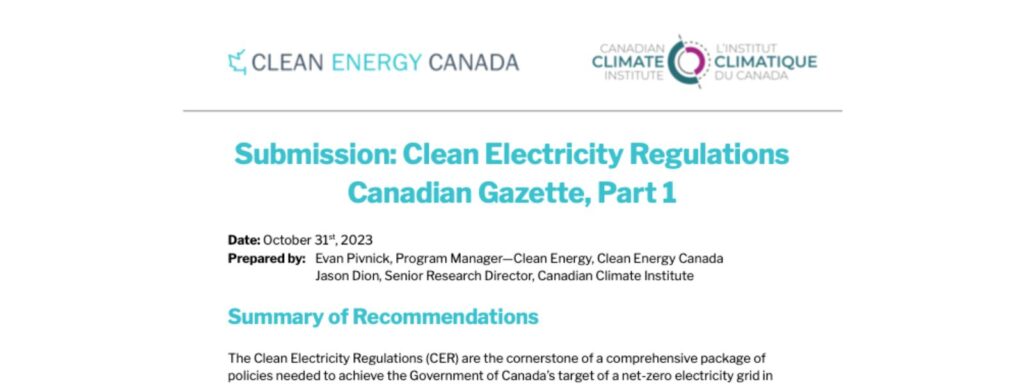In August 2023, the Government of Canada released the draft Clean Electricity Regulations (CER), outlining the details of a major new policy that is to play a critical role in decarbonizing the country’s electricity grids, building on clean electricity’s competitive advantage. There are many opinions about whether the regulations have struck the right balance in attempting to drive significant emission reductions, while ensuring electricity remains affordable and reliable.
In the first part of this two-part series, we looked at some of the important design elements and the trade-offs they sought to balance. In part two, we put the regulations in a broader context, discussing some of the other electricity policies that together can move Canada towards a net zero electricity grid by 2035.
The past several years have seen significant changes in the electricity policy landscape, with the federal government embracing a leadership role in at least two specific areas: addressing carbon pollution and providing funding for grid transformation and the deployment of cleaner electricity and infrastructure.
Action in each of these areas has come with its own policies that play a critical role in achieving our net zero goals, but also have limitations about what they can accomplish on their own.
Existing policies to address climate pollution
Addressing climate pollution in the electricity sector is a responsibility shared by federal and provincial governments, with the federal government enacting several major policies over the past several years to address these emissions. This has included regulations limiting the greenhouse gas emissions coming from natural gas and coal facilities, and most notably, introducing an economy-wide carbon pricing system.
Carbon pricing
Carbon pricing for industrial operations—such as electricity generators— currently falls under a carbon-pricing scheme called the output-based pricing system (OBPS). In theory, the use of a carbon pricing system in the electricity sector should help incentivize both the deployment of non-emitting energy generation technologies, as well as deter the use of emitting ones by increasing the cost of carbon-emitting power generation.
In practice, however, the application of the OBPS in the electricity sector has undermined the effectiveness of the carbon price’s ability to drive down emissions in the sector. By including electricity in the OBPS, the federal government has treated it as an “emissions-intensive and trade-exposed sector,” such as cement or steel. This protects generators from being exposed to the full carbon price despite having no real competitiveness issue justifying this treatment.
In effect, electricity generators are only paying the carbon price on emissions above specified benchmarks. That means only a proportion of total emissions from the sector face the full carbon.
These design issues weaken the price signal by reducing both the total carbon price fossil fuel plants pay and the advantage realized by non- or lower-emitting generation. In essence, gas- and coal-fired power plants are awarded substantial output subsidies in the form of free emissions allocations, which are denied to non-emitting generation like renewable energy.
While there is no question that carbon pricing can and should play an important role in reducing emissions in the sector, these design choices limit its effectiveness. Furthermore, independent research has shown that the Canadian government cannot rely on the carbon price alone to achieve the emission reductions in the electricity sector to reach the goal of a net-zero electricity grid in 2035.
As has been argued elsewhere, the CER and a reformed carbon price on electricity can complement each other, working together to achieve the government’s 2035 net-zero targets—but only if we design them to effectively send the right signals.
Incentivizing clean investments
A second critical policy area where the federal government has acted is in establishing new funding mechanisms to support the rapid deployment of clean technologies. Decarbonizing our electricity grids and our economy requires investment, and the pace and scale with which action is required means we need mechanisms that don’t simply saddle homeowners and businesses with the bill.
To address this, the federal government has established a variety of new funding mechanisms. Most notably, these include new direction to the Infrastructure Bank of Canada, and new measures announced in Budget 2023 such as investment tax credits (ITCs) and funding programs like the Smart Renewables and Electrification Pathways Program (SREP).
These funding programs can help ensure that the transition to clean electricity is affordable for Canadians. And according to research by the Canadian Climate Institute, the funding in Budget 2023 is particularly impactful for provinces with more emissions-intensive grids, such as Alberta, Saskatchewan, Nova Scotia and New Brunswick, with the opportunity to receive almost 33 per cent more funding than hydro-rich provinces per gigawatt of current capacity.
However, these programs only represent potential federal investments on offer. In order to unlock that federal funding, provinces must commit to building non-emitting electricity generation and related infrastructure (the federal Finance Department is still consulting on what conditions the funding will include—see here for recommendations).
For meaningful change to occur, provinces will need to act. So while the federal incentives are pivotal, they are again only a piece of the puzzle.
How to reach net zero electricity by 2035
It’s within this existing electricity policy ecosystem that the Clean Electricity Regulations have been proposed. To be effective, the regulations have to either complement existing programs by strengthening the signals and incentives, or address gaps in the current approach.
So how do all these pieces come together to achieve a net-zero electricity grid by 2035?
The short answer is more needs to be done.
As noted, the Clean Electricity Regulations were never designed to completely eliminate emissions from the electricity sector on their own. With a non-zero emission standard (currently set at 30 CO2e/GWh) and flexibilities for fossil fuel plants to emit beyond 2035 (through measures including a “prescribed life” provision and exemptions for peakers), the CER will still allow some grid emissions.
This is both intentional and an important feature of the CER. Trying to solve every challenge we face, or saddling the regulations with the full responsibility to deliver a net-zero grid, would be a mistake that drives both increased costs and could hurt the Regulations ability to ensure the needed flexibility is maintained.
Instead we need to look at the broader suite of both current and forthcoming electricity policies.
Both the carbon price and federal investments through the ITCs will be essential complements to the regulations, and will help form a coherent electricity policy package to achieve the 2035 net-zero target.
Carbon pricing for the sector should be strengthened to send an essential price signal to disincentivize the use of unabated natural gas, ensuring that we are only making use of the flexibility provided in the CER when the use of gas is most needed. This means reforming how the OBPS is applied to the electricity sector, ensuring that emitting generation is subject to the full carbon price.
The federal funding and ITCs, once finalized, will help reduce the costs of the transition, ensuring rate payers aren’t on the hook for the full costs of switching to cleaner electricity. This will be crucial to preserve energy affordability, and provide financial incentives for provinces to quickly build the necessary infrastructure.
Beyond these two policy areas, however, there is one final policy that is needed: one that addresses the accounting — and offsetting — of any residual emissions that remain after the regulations and other complementary policies have reduced them to the greatest extent possible.
The federal government taking the lead in offsetting residual emissions will be essential to actually achieve net zero emissions in the electricity sector by 2035. But it can also serve as an important opportunity to build Canadian expertise and capacity in negative emission technologies that will be essential in other climate policy areas. It could prove to be an important clean growth sector for Canada. We will have more to say about how the procurement of these offsetting negative emissions can and should work in our official submission.
Next steps for the CER
The government is currently consulting on the design for the Clean Electricity Regulations. Clean Energy Canada and the Canadian Climate Institute will be weighing in on both the specific design details for the CER, as well as the larger policy context we’ve outlined here.
This includes more details concerning the reforms needed to the OBPS, and how the government can deal with the residual emissions that remain after the CER and other policies have reduced them to the greatest extent possible.









